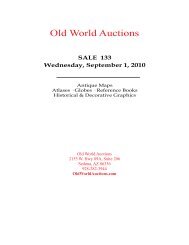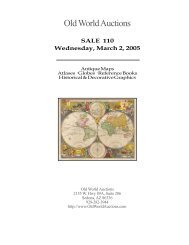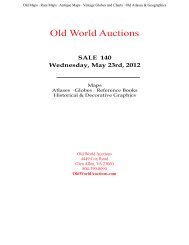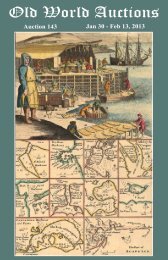PDF catalog - Old World Auctions
PDF catalog - Old World Auctions
PDF catalog - Old World Auctions
You also want an ePaper? Increase the reach of your titles
YUMPU automatically turns print PDFs into web optimized ePapers that Google loves.
<strong>Old</strong> Maps · Rare Maps · Antique Maps · Vintage Globes and Charts · <strong>Old</strong> Atlases & GeographiesNew Zealand’s western coastline is depicted as well as a group of Polynesian islands. In South America, the mythical Lago de los Xarayes is shown at the centerof the continent. The sheet is decorated with evocative, somewhat naïve figures representing the natives of continents. According to Shirley these maps appearedin Happel’s Mundus Mirabilis (1687) and Historia Moderna Europae (1692) and may have been included in other works published by Matthaeus Wagner. Ref:Shirley (Corrigenda and Addenda) #535A; Shirley (Map Collector #64) p. 4. Watermarked paper with a few small, faint spots and a short centerfold separationin top blank margin. A small surface chip in North America has been professionally repaired. There are a few small damp stains and light soiling in wide, blankmargins. (B+) $1400-180078. Western Hemisphere (L’Amerique Suivant le R.P. Charlevoix Jte. Mr. de la Condamine, et Plusieurs Autres Nouvle. Observations), Le Rouge, Paris, 1746. 24.5x 19.5”. (HC) This is the first state of this map showing the recent discoveries in North and South America. The entire northwest coast of North America iscompletely blank with the bold Riv. de l’ Ouest (River of the West) stretching from Lake Superior to the Pacific, based on the reports of the Jesuit missionary,Pierre de Charlevoix. In South America the Amazon River is detailed according to Charles Marie de la Condamine’s expedition. This is a very early record ofCondamine’s incredible 10-year adventure from 1735-45; his journal of the expedition was not published until 1751. A text table details the colonial possessions.Ref: McGuirk #15. Watermarked paper with a printer’s crease at top near centerfold and some chips in the bottom margin, one of which affects a thumbnail sizepart of the border, with the neatlines drawn in facsimile. There are two tiny worm holes in unengraved areas of map that have been closed with old paper. (B+)$600-75079. Western Hemisphere (Americae Mappa Generalis Secundum Legitimas Projectionis Stereographicae Regulas, … Concinnata et Delineata ab Aug. Gott BoehmioPhil. Magistro. In Lucem Proferentibus Homannianis Heredibus A. MDCCXXXXVI), Haas/Homann Heirs, Nuremberg, 1746. 21.3 x 18.5”. (HC) This is ahandsome, decorative eighteenth century map of the Americas with considerable detail throughout. It extends to the western part of Africa and southwest Europe.There is only an amorphous coastline shown above the peninsular California, with the Pacific Northwest left blank. The very large title cartouche includes twoerupting volcanoes, Native Americans, palm trees, sugar cane, parrots and a pot of gold. Johann Matthias Haas was a professor of mathematics at Wittenberg, andhe worked with the Homann Heirs updating their map stock. A nice impression in the cartouche, which is weak on many examples of the map. Watermarkedpaper with a crease adjacent to centerfold, two unobtrusive stains along the centerfold (one in northern Canada and one in Guyana), and a few minor spots of foxing.(B+) $550-65080. Western Hemisphere (L’Amerique Dressee pour l’Etude de la Geographie…), Brion de la Tour/Desnos, Atlas General, Civil et Ecclesiastique…, Paris, 1764. 12x 11”. (HC) Very decorative map with a landscape-style title cartouche and numerous sailing ships, some engaged in battle. While the interior of the map containslittle cartographic information, the northwest part of North America is quite interesting. A large bay labeled Entrée de Martin d’Aguilar en 1603 indents thecoastline, while above that, a river and lake system provide a complex Northwest Passage. Just above this fictitious passage is a notation that the existence of a Seaof the West is questionable. The map is surrounded by a decorative rococo-style border, printed from a separate plate as the map. Ref: McGuirk #130. Originalcolor on watermarked paper with a few small, insignificant spots, and light toning along sheet edges. (A) $200-24081. Western Hemisphere (Hemisphere Occidental), Brion de la Tour/Desnos, Atlas General, Civil et Ecclesiastique…, Paris, [1768]. 11.8 x 10.8”. (HC) The mapmakerdevised an interesting method to depict the conflicting theories on the true nature of the Pacific coast of North America. Philip Buache’s concepts, including themythical Mer de l’ Ouest and B. de l’ Ouest with its Northwest Passage, are engraved in faint hachure and colored in yellow. While the ideas of Gerhard FriedrichMuller, which includes the fabled River of the West (R. de l’ Ouest) connecting through a network of lakes into both Lake Superior and Hudson Bay, are shown bya solid line. There is no sign of Antarctica and the coastline of New Zealand is indistinctly shown. The oceans are filled with the tracks of the major explorations.The map is surrounded by a decorative rococo-style border, printed from a separate plate as the map. Ref: McGuirk #129. Original color on watermarked paperwith light color offsetting, two minute worm holes in bottom border, and a hint of toning along sheet edges. (B+) $120-15082. Western Hemisphere (Carte d’Amerique Dressee pour l’Usage du Roy…), Delisle, Paris, 1780. 24.3 x 19.3”. (HC) Guillaume Delisle’s map of the Americas[1722] was one of the most popular maps of the 18th century with numerous editions published. Its various editions provide a great view of the evolving cartographicknowledge of the Americas throughout the eighteenth century. This is the ninth state published. In North America the western coast is now continued northwardabove Cap Blanc and the mythical Sea of the West has been removed from the map. The region of central Canada has been extensively updated to included severallarge lakes and forts. The French territory of Louisiane takes up the lion’s share of North America at the expense of the British colonies. This political bias is dueto Delisle’s position as geographer to the King of France. The west end of Hudson Bay is completed and the names reflect recent British explorations in the region.South America is much better represented with a good depiction of the river systems and locations of the Jesuit missions. Several notations throughout the maphave been extended in this edition. Ref: Tooley (Amer) p. 15, #9, plt. 4. Watermarked paper with some stains and a number of short tears and small holes alongthe centerfold mostly closed on verso with archival material. (B) $650-85083. Western Hemisphere (Isles, Caps et Ports de Mer de l’Amerique), Clouet, Paris, ca. 1787. 21.5 x 12.5”. (HC) This map of the Americas is presented in a style thatgained great popularity in France at the end of the 18th century, where the map is flanked by lengthy text panels. The map itself presents very little inland detailand the western coast of North America is not delineated and noted as Parts Unknown (Pays inconnu). There is good detail of the coastline along both continentsnaming places such as Long Island, Charles Town and Cape Horn. The map size is 13.5” x 12.5”. (A) $180-22084. Western Hemisphere (Amerique ou Nouveau Continent Dressee sur les Nouvelles Relations…), Nolin, Paris, 1795. 21.2 x 18.5”. (BW) Very handsome and raremap of the Americas decorated with a large title cartouche depicting two Indians smoking a peace pipe and preparing smoke signals. The cartouche is embellishedwith huge flowering plants that conveniently obscure the northwest coast of North America. However, an inset at bottom completes the picture with the Delisle/Buache theories of a Northwest Passage. This is a later edition with the tracks of several recent explorations shown throughout the oceans. Panels of French textdescribe the various nations. Originally by Nolin, the map was “corrected and augmented” by L. Denis and published by Basset. Overall size with text on eachside of map is 26.5 x 18.5”. Watermarked paper with faded original outline color. There are some minute worm holes and tracks, soiling, faint damp stains, andsmall rust spots in and near title cartouche. There is a long horizontal crease with a small hole at center that has been closed on verso with old linen, a couple oftiny holes just below title cartouche, and an archivally repaired tear that just enters text panel at left. The map features an interesting and decorative method fordisplay; it has been surrounded by a red and black painted border, and old linen loops have been attached at each corner for hanging purposes. The borders appearto be quite old, as evidenced by the damp stains, small cracks and worm holes. (C+) $850-100085. Western Hemisphere (America), Thomson, New General Atlas, Edinburgh, 1813. 23.5 x 19.5”. (HC) In Thomson’s style, this well engraved map shows the latestdiscoveries including those of Mackenzie, Hearne, and Lewis & Clark. The map extends to include the coasts of Europe and West Africa, and it presents good detailof islands in the eastern portion of the South Pacific. The United States is shown north of East and West Florida, and east of the Mississippi River. The land westof the Mississippi is called Louisiana and the northwest is largely void of detail. Hawaii is named Sandwich Isles. Ref: Phillips (A) 731-52. There is offsettingin the image and a tear that enters 1” into map at bottom that has been closed on verso with archival tape. There is an unrepaired centerfold separation at top thatjust passes the neatline, and one at bottom that enters 7.5” into map and has been partially closed on verso. (B) $230-27586. Western Hemisphere (Il Nuovo Mondo Diviso nelle sue Principali Contrade), Marmocchi, Corso di Geografia Universale, Genoa, ca. 1838. 20 x 19.8”. (HC)On this map of the “New <strong>World</strong>” North America is named Colombia and South America is named America. The name Columbia first appeared in 1738, and wasmeant to represent the European colonies in the New <strong>World</strong>, and later became the female personification of the United States of America. On this map the mountainranges and river systems are well defined, although not entirely accurate; the mythical L. Xarayes still appears in South America. Numerous place names are notedthroughout, although boundary lines between countries and states are not delineated. The map includes good detail of the surrounding islands, and features eightnational flags: the United States, Haiti, Peru, Brazil, Chili, Argentina (referred to as Buenos Ayres), Colombia, and Mexico. Interestingly, the United States flag isdepicted with 15 stripes and 26 stars in the formation of a star. The US flag added its 26th star in January 1837, when Michigan gained statehood, and didn’t addanother star until 1845. The 26-star flag was presented with two different star formations - arranged both in horizontal lines and in a star formation - but alwayswith 13 stripes, although there was a period from 1795-1818 during which the US flag had 15 stripes and 15 stars. Engraved by Castellini. Issued folding onwatermarked paper with small, scattered stains, two minute worm holes, and a few tiny fold separations that have been archivally repaired. There is minor crumplingalong sheet edges, not affecting map. (B+) $400-500
















